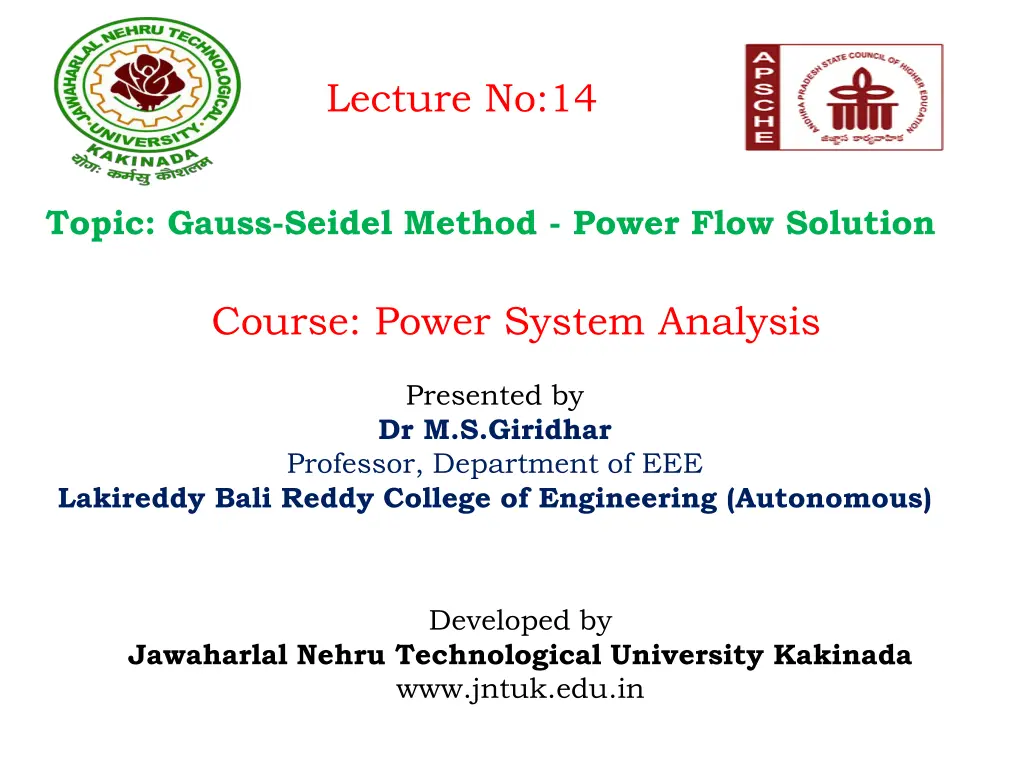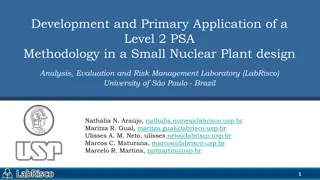
Gauss-Seidel Method for Power Flow Solution
"Learn about the Gauss-Seidel method for solving power flow problems in power system analysis. Dive into mathematical formulations, iterative steps, and practical applications with Dr. M.S. Giridhar."
Download Presentation

Please find below an Image/Link to download the presentation.
The content on the website is provided AS IS for your information and personal use only. It may not be sold, licensed, or shared on other websites without obtaining consent from the author. If you encounter any issues during the download, it is possible that the publisher has removed the file from their server.
You are allowed to download the files provided on this website for personal or commercial use, subject to the condition that they are used lawfully. All files are the property of their respective owners.
The content on the website is provided AS IS for your information and personal use only. It may not be sold, licensed, or shared on other websites without obtaining consent from the author.
E N D
Presentation Transcript
Lecture No:14 Topic: Gauss-Seidel Method - Power Flow Solution Course: Power System Analysis Presented by Dr M.S.Giridhar Professor, Department of EEE Lakireddy Bali Reddy College of Engineering (Autonomous) Developed by Jawaharlal Nehru Technological University Kakinada www.jntuk.edu.in
Power flow problem I2 ith BUS Ik Ii Im n = In + I Y V Y V i ik k ii i =1 k k i n = k = = i 1,2.....n Y V I Y V ii i i ik k 1 i k
Gauss-Seidel Power Flow Solution-Mathematical Formulation P jQ = i i I = + = * i S P jQ V I i * V i i i i i 1 Y n = k = = i 1,2.....n V I Y V i i ik k 1 i k ii V 1 Y n P jQ = k = = i 1,2.....n i i V Y V i ik k * 1 i k ii i
A one-line diagram for a four-bus system is shown in figure. The line impedances are given in table. Form YBUS by singular transformation (choose Bus 1 as reference bus), Determine the voltages at the end of first iteration using GS-method? 1 2 Initial Value 3 4 Line (Bus to Bus) 1 2 1 3 2 3 2 4 3 4 R X G B Bus No. 1 2 3 4 Pi - 0.5 -1.0 0.3 Qi - -0.2 0.5 -0.1 Vi Remarks Slack PQ PQ PQ (p.u.) 0.05 0.1 0.15 0.1 0.05 (p.u.) 0.15 0.3 0.45 0.3 0.15 (p.u.) 2 1 0.666 1 2 (p.u.) -6 -3 -2 -3 -6 1.04 1.0 1.0 1.0
2 + ?6 (?.??? ???) 0.666 + ?2 1 + ?3 1 + ?3 0.666 + ?2 3.666 ?11 2 + ?6 0 3 ?9 2 + ?6 1 + ?3 0 1 + ?3 2 + ?6 3 ?9 ????= ?22 ?2 ??2 ?20 1 ?21?1 ?23?30 ?24?40 ?21= ?+?? ?.?? ?.???+?? ? ?+?? (?) ? ?.? ?( ?.?) ?= ?? ?.??? ??? ? 1= 1.019 +?0.046 ?.? ?2
CASE-I (1-slack bus and all other buses are PQ-buses) Algorithm for power flow solution: The slack bus voltage magnitude and angle are assumed, usually V1 00 p.u. with the load profile known at each bus (i.e PDi and QDi are known). We allocate PGi and QGi to all generating stations. With this step, bus injections (Pi+jQi) are known at all buses other than the slack bus. Form YBUS using singular transformation method form the selected graph for the given one-line diagram of the power system. Compute the bus voltages using the iterative voltage equation as
Iterative steps 1 i n A = k = i k Y ik + + = = 1 1 r r r i 1,2....n i V B V B V ( ) i V i ik k ik k * r + 1 1 P jQ = = 3 , 2 .... B k n k i = i i A ik Y i Y ii ii + + = = 1 1 r r r 3 , 2 ,.... V V V i n Check for the convergence i i i Is V V V i i i min max = If then fix V V V V i i i i min min = If then fix V V V V i i i i max max
Line power Flows Compute the line flow from the obtained bus voltages in step-3 = + = + V ( ) I I I V Y V Y 1 ik iko ik i k ik i iko Compute the power flow from the obtained bus voltages in step-3 and currents from step-5 = + = = + * * * * V ( ) S P jQ V I V V Y V V Y ik ik ik i ik i i k ik i i iko BUS-i ??????1??????1??? BUS-k
Convergence Acceleration of Convergence Convergence in the gauss-seidal method can some times be speeded up by the use of the acceleration factor + + = + 1 1 r r r r ( ) V V V V i i i i Where is a real number (generally = 1.6)






















